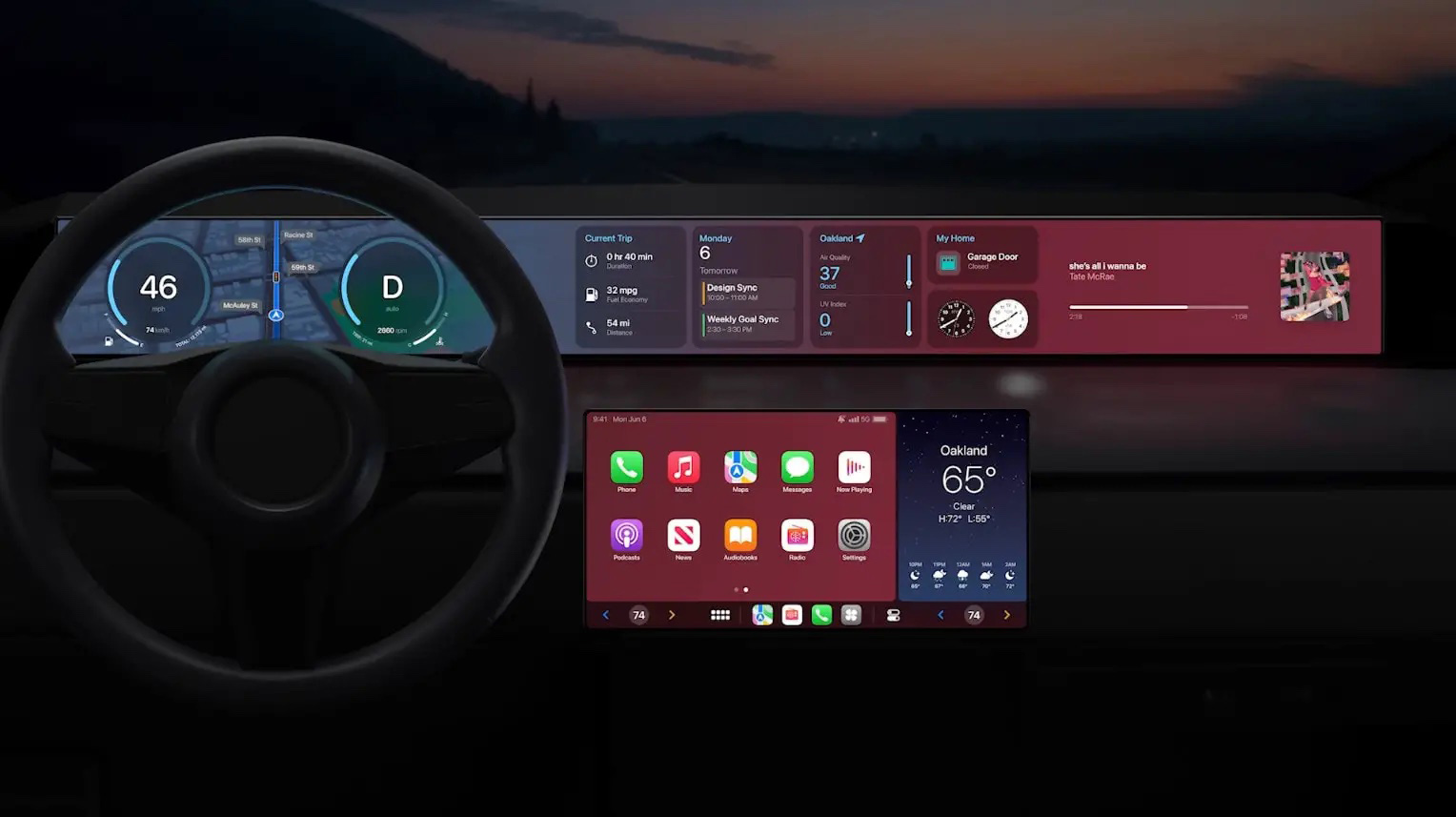Apple’s vision for next-gen CarPlay, announced at the Worldwide Developers Conference (WWDC) 2022, involves comprehensive integration where the CarPlay UI would take over most, if not all, vehicle displays.
This ambitious plan includes feeding car system data to the iPhone and displaying it across various screens, including the instrument cluster. Initially, numerous major car manufacturers such as Porsche, Land Rover, Mercedes-Benz, Lincoln, Audi, and others expressed interest.
However, progress has stalled, and many manufacturers have remained silent about their plans. Notably, Mercedes-Benz has explicitly stated it will not support next-gen CarPlay, focusing instead on its own Mercedes-Benz operating system set to debut next year.
The Vision for Next-Gen CarPlay
The current CarPlay setup is relatively straightforward: users connect their iPhone to the car, and the CarPlay UI is displayed on one of the vehicle’s screens.
This provides a consistent, user-friendly interface that integrates with the iPhone’s apps and services.
However, Apple’s next-gen CarPlay aims to go beyond this, integrating deeply with the car’s hardware to display a unified interface across multiple screens, including critical ones like the instrument cluster.
Apple’s proposal is for car systems to feed data directly to the iPhone, which would then render the information on the car’s displays. This deeper integration promises a more seamless and cohesive user experience, merging the smartphone and driving environments more completely than ever before.

Challenges & Resistance from Automakers
Despite the initial excitement, automakers have shown reluctance to fully embrace this vision. One significant reason is the substantial investment many companies have already made in developing their own operating systems.
For example, Mercedes-Benz, initially listed as a partner, has since backed out. CEO Ola Källenius clarified that Mercedes-Benz is committed to launching its own operating system next year, emphasizing the company’s desire to retain control over its in-car experience.
Many automakers have developed advanced, feature-rich interfaces often built on platforms like Unreal Engine, incorporating sophisticated animations and integrations with services such as Google Maps.
Abandoning these custom interfaces for Apple’s could mean losing unique brand differentiation and control over the user experience.
Introducing Punch-Through as a Compromise
Apple’s punch-through feature offers a middle ground. Initially designed to allow the car’s native UI to take over for specific functions like engaging backup cameras, this feature can be extended to give automakers more control.
With punch-through, car systems can temporarily override CarPlay whenever necessary. This flexibility could make next-gen CarPlay more appealing to manufacturers who want to retain key elements of their user interface.
As The Verge notes, automakers can use punch-through for various purposes, including linking CarPlay buttons to their own systems.
This arrangement allows manufacturers to choose exactly when to use their native UI and when to allow CarPlay to take over. It acknowledges the investments car companies have made in their operating systems while still offering the seamless integration Apple envisions.

Potential Benefits & Drawbacks
The punch-through feature has the potential to unlock several benefits. For users, it could mean a more integrated experience that combines the best of both worlds: Apple’s intuitive interface and the car’s native features.
For automakers, it offers a way to adopt next-gen CarPlay without completely overhauling their systems.
However, there are potential drawbacks.
The mix-and-match approach could lead to a fragmented user experience, where the interface switches between CarPlay and the car’s native system unpredictably. This could confuse users and detract from the seamless experience Apple aims to provide.
Looking Ahead
While the punch-through feature may not be the perfect solution, it represents a significant step toward reconciling Apple’s vision with the realities of the automotive industry.
By allowing carmakers to retain some control over their interfaces, Apple hopes to persuade more manufacturers to adopt next-gen CarPlay.
The future of next-gen CarPlay depends on the ability of Apple and car manufacturers to find common ground. If the punch-through compromise proves successful, it could lead to broader adoption and a new era of in-car integration.
As the automotive and tech industries continue to evolve, collaboration and flexibility will be key to delivering innovative, user-friendly solutions.

The punch-through feature offers a practical solution to the impasse between Apple and car manufacturers, potentially paving the way for broader acceptance of next-gen CarPlay.
As both sides navigate this complex landscape, the focus will remain on enhancing the driving experience through advanced technology and seamless integration.









